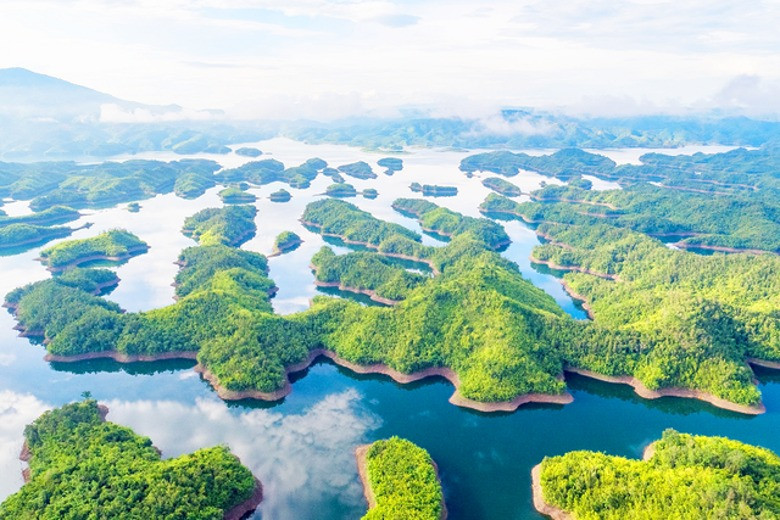
Dak Nong Geopark has been recognized as a UNESCO Global Geopark in 2020.
With the goal of helping the global geopark network develop sustainably, a working group led by Mr. Jianping Zhang - Vice Chairman of the UNESCO Global Geopark Council and had the participation of Mr. Marekazu Ohno from the Japan National UNESCO Committee has just come to Dak Nong province to carry out field re-evaluation at the Dak Nong UNESCO Global Geopark.
It is expected that the group will conduct a field survey and evaluation of the tourist route "The Epic of Fire and Water" starting from Gia Nghia City to Gia Long Waterfall (H.Krong No district); survey the "Symphony of the New Wind" tourist route which starts from H.Cu Jut to Gia Nghia City. In addition, the group will survey the tourist route starting from Gia Nghia City to Ta Dung Lake (Dak Glong District).
The results of the re-evaluation trip at the UNESCO Dak Nong Global Geopark will be discussed and voted on by the Global Geopark Council in November 2023. The official notice will be sent to Dak Nong province in the first quarter of 2024.
Unique paleogeological heritage sites
Established in 2015, the Dak Nong Global Geopark is a red land area covering an area of 4,760 km2, with a system of 50 caves totalling nearly 10,000 m long in the districts of Krong No, Cu Jut, Dak Mil, Dak Song, Dak G'long and Gia Nghia town.
Dak Nong Geopark has about 65 geological and geomorphological heritage sites, including a system of nearly 50 caves with a total length of more than 10,000 m, volcanic craters, waterfalls... Among them, the outstanding mountain cave C7 with a length of 1,266m, is considered the longest lava cave in Southeast Asia.
This place has long been famous as a red land with a tropical forest ecosystem, which preserves typical biodiversity values. This land also preserves many unique cultural, geological, and natural features as well as traces of prehistoric activities.
The most special feature in the Dak Nong Geopark is the cave system in basalt rock, distributed in the Dray Sap-Chu R'Luh area, discovered since 2007. This volcanic cave system was recognized by the Japanese Volcanic Cave Association as a Southeast Asian record in terms of scale, length and uniqueness. The caves still contain many secrets about formation mechanisms, mineral complexes, biodiversity and archaeological sites...
In the Geopark area, there are also paleontological geological heritages such as fossils of ammonites, oysters, bivalves... to prove that in this period this place was still part of the vast ocean.
In addition, there are natural lakes and systems of beautiful, majestic waterfalls such as Gia Long waterfall, Trinh Nu waterfall, Dray Sap waterfall...
In addition, Dak Nong Geopark also has bauxite, antimony, tin placer, pozzolan, precious stone mines and especially large-sized semi-precious stones opal – chalcedon mines.
After the discoveries of archaeological sites of prehistoric people living in the volcanic cave area of the Geopark, initial research results along with the collection of archaeological relics are quite dense, recognizing that this as a cultural vestige of Late Neolithic and Early Metal Age dating back to 6,000-3,000 years ago.
Regarding ceramics, there are many types of items, with different thicknesses and thinness, made from sandy clay. The patterns on the ceramic pieces are quite sharp and diverse such as dotted bricks, fabric bricks, rope patterns... There are also animal bones, animal bone fragments and even prehistoric human bones.
Abundant potential for developing ecotourism models
The flora and fauna system in the geopark is very rich with many rare breeds and species, listed in Vietnam and the world's red books such as elephants, tigers, bison and many primates (white-cheeked langur, white-cheeked langur, Black-shanked Douc, reptile, Hornbill, Red-fronted Chicken); Three-edged Oak, Dinh Tung, Sao, Trac, Giang Huong, Cam Xe wood... This is great potential for the Geopark to develop attractive models of eco-tourism, exploration, research on biodiversity tours, attracting scientists as well as domestic and foreign tourists come to visit and research.
Dak Nong Geopark is a model helping visitors learn about the formation of the earth, through geotourism. In Dak Nong Geopark, there are 5 volcanoes, including Nam Dong, Bang Mo (Cu Jut district), Nam Blang, Nam Kar (Krong No district) and Nam Gle (Dak Mil district). Among these, the highlight is C7 cave with a length of 1,067m, determined to be the longest lava cave in Southeast Asia, followed by C6.1 cave, which is more than 968 meters long and cave C3 (also known as Bat cave) which is 594 meters long.
Committed to implementing UNESCO criteria
The implementation of the commitments in the process of operating the Global Geopark will be an important contribution to the province's overall development planning in a sustainable direction.
On the foundation of the geopark, Dak Nong Province has been strictly implementing UNESCO's goals and criteria on building and developing sustainable socio-economic development associated with environmental protection and nature conservation, rational use of all types of resources, all heritage values, preserving and promoting national cultural identity, especially promoting the potential and strengths of the province in the field of tourism to attract r domestic and international tourists.
Four years after receiving the title, the UNESCO Dak Nong Global Geopark has initially built a system of facilities on 3 geological experience tourist routes, strictly implementing conservation of landscape and geological and cultural values, plans to improve people's livelihoods, especially with promotional, educational, environmental activities, tourism links and international cooperation, participating in activities of the geopark network, contributing to raising community awareness about Geoparks, enhancing the role and position of the UNESCO Dak Nong Global Geopark on the domestic and international tourism map.